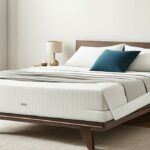Last Updated on 3 months by Francis
Making your bed in the morning can be frustrating when your fitted sheets keep slipping off the corners of the mattress. Fortunately, there are several hacks to ensure your fitted bed sheet stays snug throughout the night.
Contents
Key Takeaways
- Use sheet suspenders to keep your sheets snug on the mattress.
- Place an under-sheet for extra friction, especially with softer materials like satin or silk sheets.
- Utilize rug corners to reduce slipping.
- Attach safety pins to secure your sheets to the bottom of the mattress.
- Properly stretch your sheets, starting with the top corners, to help them stay in place.
Using Sheet Suspenders
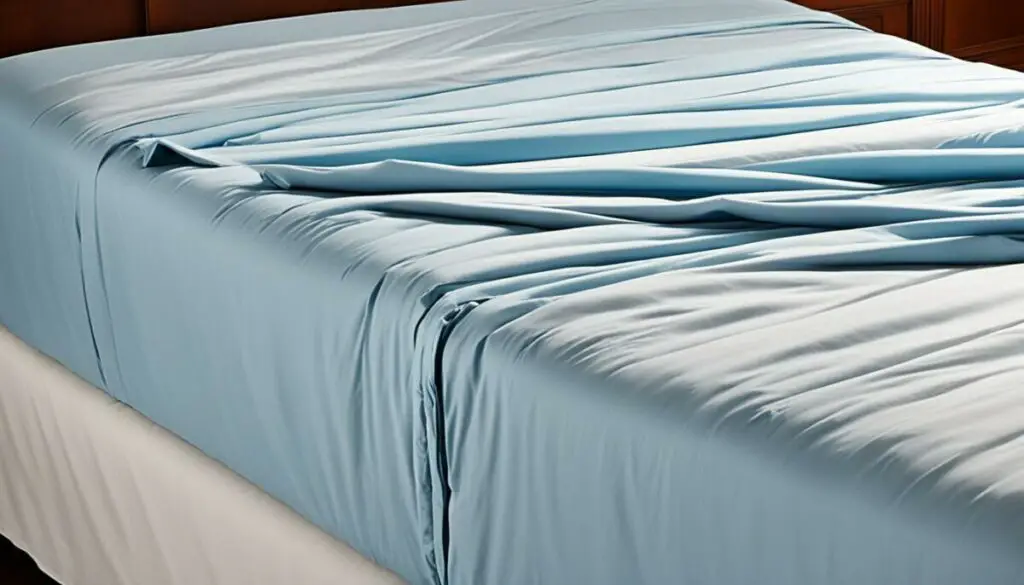
If you’re tired of constantly readjusting your bed sheets, sheet suspenders are here to save the day. These ingenious elastic straps with locking mechanisms go on the bottom corners of your sheets, providing a secure and snug fit on your mattress.
Sheet suspenders are readily available at most retailers and mattress stores, making them easily accessible and affordable. By investing in these simple and effective tools, you can say goodbye to the frustration of waking up to tangled and loose sheets.
Sheet suspenders work by securely anchoring your fitted sheet to the mattress corners, preventing any unwanted movement. The elastic straps create tension, ensuring that your sheets stay in place throughout the night, even if you toss and turn.
For those seeking an extra level of security, criss-cross sheet suspenders are an excellent option. By crossing the elastic straps diagonally underneath the mattress, you can achieve an even tighter fit, providing maximum stability and peace of mind.
Whether you have a standard or deep pocket mattress, sheet suspenders are adjustable to accommodate various mattress sizes and thicknesses. With their versatile design and locking mechanisms, these elastic straps make it effortless to achieve a neat and wrinkle-free bed.
So, say goodbye to waking up in a bundle of loose sheets and hello to a perfectly made bed every morning with sheet suspenders.
| Benefits of Sheet Suspenders | Additional Notes |
|---|---|
| 1. Secure and snug fit for bed sheets | – Available at most retailers and mattress stores |
| 2. Adjustable elastic straps with locking mechanisms | – Affordable solution to keep sheets from slipping |
| 3. Criss-cross design for enhanced security | – Suitable for various mattress sizes and thicknesses |
| 4. Easy installation and removal | – Helps achieve a neat and wrinkle-free bed |
Using an Under-sheet
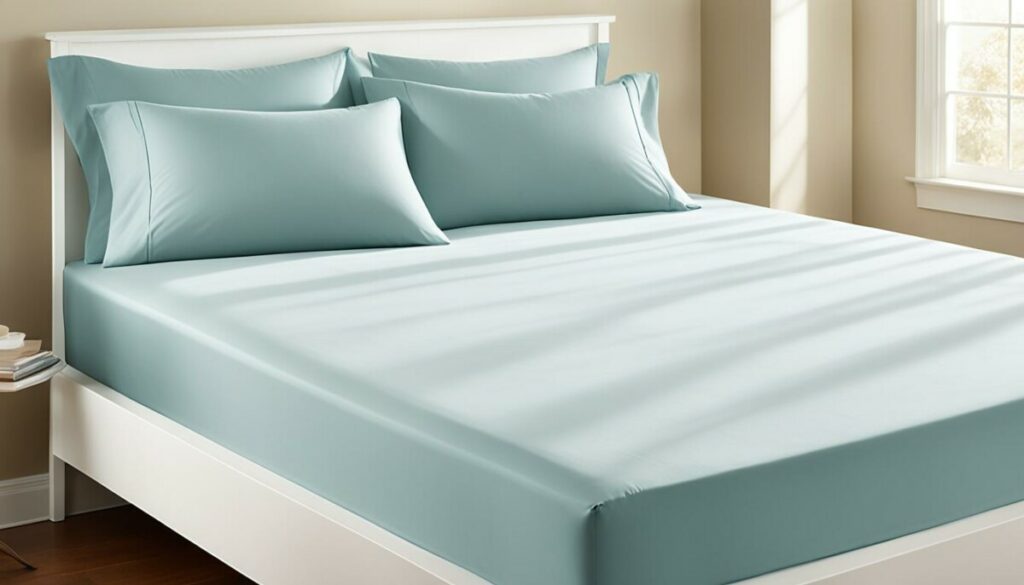
When it comes to preventing slippage, an under-sheet can be a game-changer. By placing a rougher textured sheet underneath your fitted sheet, you can create additional friction that keeps everything in place throughout the night. This is especially beneficial for those who prefer the luxurious feel of satin or silk sheets.
When choosing an under-sheet, consider materials like flannel or fleece. These fabrics provide the necessary texture to prevent slippage and ensure a snug fit. However, it’s important to note that flannel and fleece may not be the best choice for hot sleepers, as they can be too warm during the night.
Benefits of Using an Under-sheet:
- Increased friction for a secure fit
- Suitable for satin and silk sheets
- Prevents slippage throughout the night
Incorporating an under-sheet into your bedding setup adds an extra layer of stability and comfort. With the right under-sheet, you can enjoy the silky smoothness of satin or silk sheets without sacrificing a snug fit.
To help you visualize how an under-sheet can improve your bedding experience, take a look at the following hypothetical scenario:
| Scenario | Without Under-sheet | With Under-sheet |
|---|---|---|
| Slippage | Sheets constantly coming loose and requiring adjustment | Sheets stay securely in place throughout the night |
| Comfort | Uneven surface due to constant readjustment | Smooth and comfortable surface for a better night’s sleep |
| Maintenance | Frequent washing and reapplying of sheets | Less frequent sheet adjustments and washing |
As you can see, using an under-sheet can make a significant difference in your sleep experience, providing increased stability and comfort.
Using Rug Corners
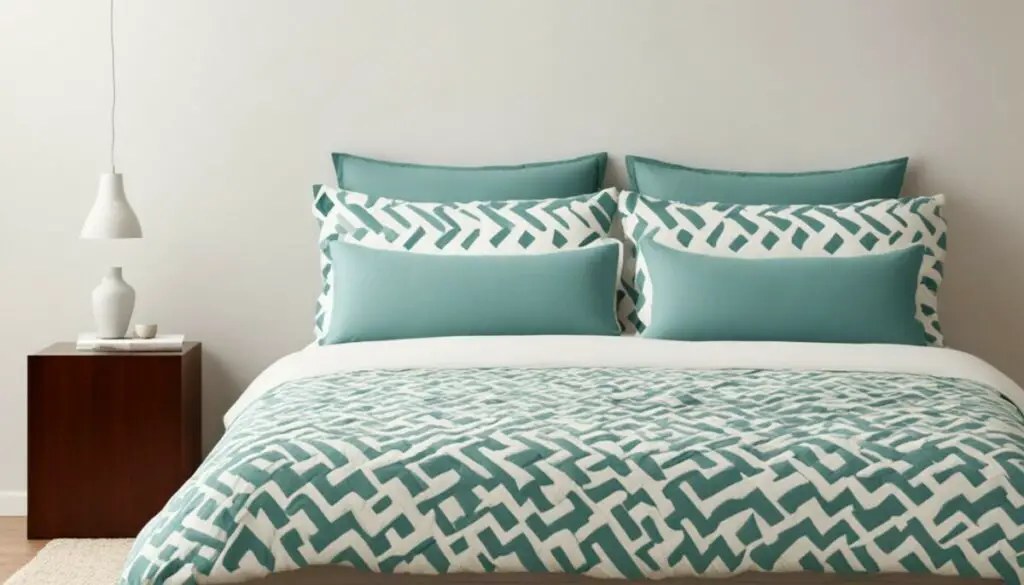
If you’re looking for a simple and effective way to keep your sheets in place, consider using rug corners. While they are typically used to prevent rugs from slipping, these handy corners can also be used to provide grip and prevent your sheets from sliding off the mattress. Placing rug corners on the bottom side of the sheet and ensuring they lie flat against the mattress can significantly reduce slipping, giving you a snug and secure fit.
These rug corners are typically made of durable grip material, designed to enhance friction and hold the sheets firmly in place. They can be easily found online or in home improvement stores, making it a convenient option for anyone seeking a practical solution to the age-old problem of loose bed sheets.
Attaching Safety Pins

If you’re looking for a simple and effective solution to secure your sheets and prevent them from slipping off the mattress, safety pins can be your best friend. By attaching safety pins to the bottom of your sheets, you can ensure a snug fit throughout the night.
When using safety pins, it’s important to ensure they are lying flat and secure at the bottom. This will prevent them from becoming unpinned, keeping your sheets in place and providing you with a comfortable and secure sleeping experience.
Here’s a step-by-step guide on how to attach safety pins to your sheets:
- Spread out your fitted sheet on the mattress.
- Identify the corners of the sheet that tend to slip off.
- Fold the corner of the sheet back, exposing the mattress underneath.
- Insert a safety pin through the folded corner of the sheet and into the mattress, ensuring it lies flat.
- Repeat this process for all the corners of the sheet.
- Smooth out the sheet to ensure a neat and secure fit.
By following these simple steps, you can enjoy a secure and peaceful night’s sleep without having to constantly readjust your sheets. Give it a try and say goodbye to those frustrating moments of loose sheets.
| Pros | Cons |
|---|---|
| Simple and effective solution | Requires manual attachment and removal |
| Keeps sheets secure throughout the night | May leave small pinholes in the sheets |
| Easy to adjust and remove if necessary | Safety pins may not work well with delicate or thin sheets |
Expert Tip:
Before attaching safety pins to your sheets, make sure to test them on an inconspicuous area first to avoid any damage or visible marks on your sheets. Additionally, be cautious when removing the pins to prevent any tears or small holes in the fabric.
Properly Stretching Your Sheets

One effective method to prevent your sheets from slipping off the corners of your mattress is by properly stretching them. When you start making your bed, focus on stretching the top corners of your sheets first. By doing so, you can create a tighter and more secure fit, ensuring that the sheets stay in place throughout the night.
If stretching alone doesn’t provide the desired result, you may want to consider using additional products to keep your sheets snug. Elastic straps or sheet suspenders can be helpful in enhancing the hold, especially for those who prefer a more firm and secure fit. These accessories help maintain tension and prevent the sheets from loosening or shifting during sleep.
Remember, a properly stretched sheet can make a significant difference in preventing slippage and ensuring a comfortable and uninterrupted night’s sleep.
Considering Pocket Depth
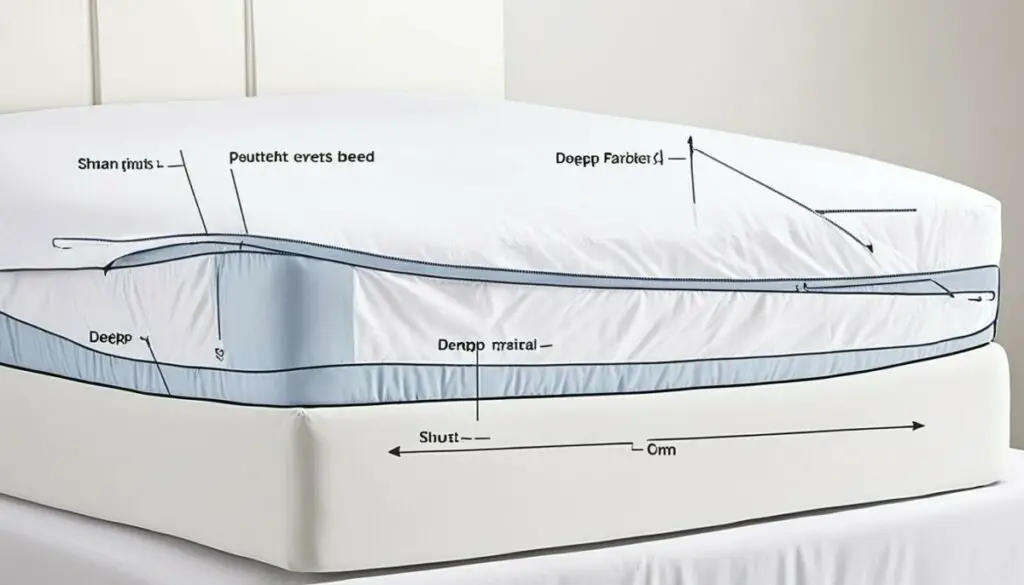
One key factor to ensure a snug fit for your sheets is matching the pocket depth to the height of your mattress. Different mattresses come in varying heights, and if you have a mattress with a pillow top or a mattress topper, it’s important to consider these additional layers when selecting your sheets.
Deep pocket sheets are designed to accommodate thicker mattresses, providing a generous amount of fabric to tuck under the mattress and keep the sheets securely in place. These sheets have deeper pockets compared to standard sheets, allowing them to fit snugly over the entire mattress.
To determine the appropriate pocket depth for your sheets, measure the height of your mattress, including any pillow top or topper. This measurement will help guide you in finding the right sheets that will fit your mattress perfectly, eliminating any excess fabric or the frustrating battle of trying to stretch a too-tight sheet over the corners.
Investing in proper measurements and considering pocket depth will ensure that your sheets fit your mattress like a glove, providing you with a comfortable and uninterrupted night’s sleep.
Tips for Measuring Pocket Depth
Here are some quick tips to help you accurately measure the pocket depth of your mattress:
- Use a measuring tape or ruler to measure from the top of your mattress to the bottom where the mattress meets the box spring or foundation.
- Take measurements from multiple points around the mattress to ensure accuracy.
- If you have a pillow top or mattress topper, include the height of these layers in your measurement.
- Round up to the nearest inch to ensure you select sheets with a pocket depth that will comfortably fit your mattress.
By taking the time to consider the pocket depth of your sheets, you’ll be able to achieve a perfect fit and enjoy the benefits of a neatly made bed each day.
Using Zippered Sheets
If you’re looking for a truly secure fit for your bed sheets, consider using zippered sheets. Unlike traditional fitted sheets that rely on elastic bands, zippered sheets offer a snug fit by zipping around the edges of the mattress. This innovative design ensures that your sheets stay in place throughout the night, no matter how much you move around.
Zippered sheets come in a variety of sizes, colors, and materials, allowing you to find the perfect fit for your bed. Whether you prefer crisp cotton sheets, luxurious silk sheets, or cozy flannel sheets, there are zippered options available to suit your preferences.
Not only do zippered sheets provide a snug fit, but they also offer other benefits. The zipper closure prevents the sheets from slipping off the corners of the mattress, eliminating the need to constantly readjust them. This can save you time and frustration each morning when making your bed.
Additionally, the zippered design creates a sleek and streamlined look on your bed, giving it a neat and tidy appearance. Whether you have a standard mattress or a thicker pillow-top mattress, zippered sheets can accommodate various mattress depths and provide a secure fit.
Investing in zippered sheets can be a game-changer for those who value a secure and snug fit for their bed linens. Say goodbye to loose and wrinkled sheets and enjoy a comfortable and stylish bed that stays put throughout the night.
Making DIY Sheet Straps
Creating your own DIY sheet straps using stretchy bands and a locking mechanism can be a simple and cost-effective solution to prevent your fitted sheets from slipping off the corners of your mattress. This project is especially beneficial for those who enjoy DIY projects and have the necessary supplies at home.
Here’s a step-by-step guide to making your own DIY sheet straps:
- Select your materials: Start by gathering the following supplies:
- Stretchy bands: Choose bands that are strong and durable, yet flexible enough to provide a secure hold on your sheets.
- Locking mechanism: Look for a small clasp or clip that can hold the stretchy bands in place once they’re secured around the corners of your sheets.
Now you have your own DIY sheet straps that will keep your fitted sheets in place all night long. Enjoy a peaceful and comfortable sleep without having to constantly readjust your sheets!
Remember, DIY sheet straps are a customizable solution that you can tailor to fit your specific needs. Feel free to experiment with different types of stretchy bands and locking mechanisms to find the perfect combination for your sheets and mattress.
Using a Mattress Pad or Topper
Looking for an effective solution to keep your fitted sheets in place? Consider adding a mattress pad or topper to your bedding setup. Not only do they provide comfort and support, but they also increase friction between the sheets and the mattress, preventing slippage throughout the night.
A mattress pad is a thin quilted material that is placed directly on top of the mattress. It acts as a barrier between the sheet and the mattress, creating a smoother surface that helps keep the sheet in place. The quilted design adds an extra layer of cushioning for enhanced comfort while preventing the fitted sheet from sliding around.
On the other hand, a mattress topper is a thicker layer of padding that provides additional cushioning and support to the mattress. In addition to improving the overall comfort of your bed, a mattress topper can also help anchor the sheet in place, thanks to the increased friction it offers.
By adding a mattress pad or topper to your bed, you not only enhance the sleep experience but also extend the life of your fitted sheet. Say goodbye to waking up to tangled sheets and enjoy a more serene and comfortable night’s sleep.
FAQ
How can I keep my bed sheets from slipping off?
There are several easy solutions to prevent your bed sheets from slipping off. One option is to use sheet suspenders, which are elastic straps with locking mechanisms that keep your sheets snug on the mattress. Another solution is to place a rougher textured sheet underneath your fitted sheet to increase friction. You can also use rug corners, attach safety pins, properly stretch your sheets, consider pocket depth, use zippered sheets, make DIY sheet straps, or use a mattress pad or topper for increased friction.
What are sheet suspenders?
Sheet suspenders are elastic straps with locking mechanisms that go on the bottom corners of your sheets to keep them snug on the mattress. They provide an affordable and practical solution to prevent your sheets from slipping. Criss-cross sheet suspenders can provide an even tighter fit and added security.
How can an under-sheet help prevent slippage?
Placing a rougher textured sheet underneath your fitted sheet can increase friction and prevent slippage, particularly with softer materials like satin or silk sheets. Materials like flannel or fleece can be used as under-sheets, but they may not be suitable for hot sleepers.
Can rug corners be used to keep sheets in place?
Yes, rug corners typically used to prevent rugs from slipping can also be utilized to keep sheets in place. These corners should be placed on the bottom side of the sheet and lie flat against the mattress to reduce slipping.
How do safety pins help in securing bed sheets?
Safety pins provide a simple and effective solution to secure your sheets to the bottom of the mattress. Make sure the safety pins are lying flat and secure at the bottom to prevent them from coming unpinned.
Is stretching the sheets necessary to prevent slippage?
Yes, stretching the top corners of your sheets first can make it easier for the sheets to stay in place. However, if stretching alone doesn’t work, you may need additional help from products like elastic straps or sheet suspenders.
Why is pocket depth important when choosing sheets?
Matching the pocket depth of your sheets to the height of your mattress is crucial for a snug fit. Mattresses with pillow tops or mattress toppers may require deep pocket sheets to accommodate the extra height. Taking proper measurements and considering pocket depth will ensure a secure fit for your sheets.
What are zippered sheets, and how do they work?
Zippered sheets are less common but provide a secure fit by zipping around the edges of the mattress instead of relying solely on elastic bands. They come in various sizes, colors, and materials and are particularly beneficial for sleepers who move around a lot during the night.
Can I make my own sheet straps?
Yes, you can create DIY sheet straps using stretchy bands and a locking mechanism. This simple and cost-effective solution is especially useful for those who enjoy DIY projects and have the necessary supplies at home.
How can a mattress pad or topper help with sheet slippage?
Adding a mattress pad or topper can increase friction between the sheets and the mattress, preventing slippage. A mattress pad is a thin quilted material placed directly on the mattress, while a mattress topper provides additional cushioning. Both options can help keep your sheets in place and prolong the life of your fitted sheet.




